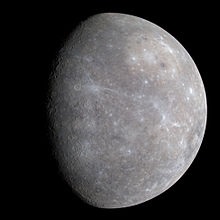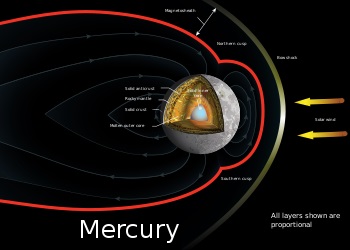|
|
| |
|
|
| |
|
|
|
|
| |
 |
| Imaged in enhanced
color by MESSENGER in 2008. |
Mercury
Mercury is the smallest planet in the Solar System. It
is the closest planet to the sun. It makes one trip
around the Sun once every 87.969 days. Mercury is bright
when it is visible from Earth, ranging from −2.0 to 5.5
in apparent magnitude. It cannot be easily seen as it is
usually too close to the Sun. Because Mercury is
normally lost in the glare of the Sun, Mercury can only
be seen in the morning or evening twilight or during a
solar eclipse.
Less is known about Mercury than about other planets of
our Solar System. Telescopes on the Earth show only a
small, bright crescent, and putting a satellite in orbit
around it is difficult. The first of two spacecraft to
visit the planet was Mariner 10, which mapped only about
45% of the planet’s surface from 1974 to 1975. The
second is the MESSENGER spacecraft, which finished
mapping the planet in March 2013.
Mercury looks like Earth's Moon. It has many craters and
areas of smooth plains, no moons around it and no
atmosphere as we know it. However, Mercury does have an
extremely thin atmosphere, known as an exosphere. Unlike
Earth's Moon, Mercury has a large iron core, which gives
off a magnetic field about 1% as strong as that of the
Earth. It is a very dense planet due to the large size
of its core. Surface temperatures can be anywhere from
about 90 to 700 K (−183 °C to 427 °C, −297 °F to 801
°F), with the subsolar point being the hottest and the
bottoms of craters near the poles being the coldest.
Known sightings of Mercury date back to at least the
first millennium BC. Before the 4th century BC, Greek
astronomers thought that Mercury was two different
objects: one able to be seen only at sunrise, which they
called Apollo; the other that was only able to be seen
at sunset, which they called Hermes. The English name
for the planet is from the Romans, who named it after
the Roman god Mercury, which they thought to be the same
as the Greek god Hermes. The symbol for Mercury is based
on Hermes' staff.
Even though Mercury is the closest planet to the Sun, it
is not the warmest. This is because it has no greenhouse
effect, so any heat that the Sun gives to it quickly
escapes into space. The hottest planet is Venus. |
|
Inside Mercury
Mercury is one of four inner planets in the Solar
System, and has a rocky body like the Earth. It is the
smallest planet in the Solar System, with a radius of
2,439.7 km (1,516.0 mi). Mercury is even smaller than
some of the largest moons in the solar system, such as
Ganymede and Titan. However, it has a greater mass than
the largest moons in the solar system. Mercury is made
of about 70% metallic and 30% silicate material.
Mercury's density is the second highest in the Solar
System at 5.427 g/cm³, only a little bit less than
Earth’s. |
|
 |
| Mercury's internal
structure and magnetic field. |
Surface of Mercury
Mercury's surface looks similar to the surface of the
Moon. It has plains that look like mares and has lots of
craters. Mercury have been hit by a lot of comets and
asteroids 4.6 billion years ago. Mercury have also been
hit during a period called the Late Heavy Bombardment.
Mercury has lots of craters because it does not have any
atmosphere to slow objects down. Images gotten by
MESSENGER have shown that Mercury may have shield
volcanoes.
The surface temperature of Mercury ranges from 100 to
700 K (−173 to 427 °C; −280 to 800 °F) at the most
extreme places. Even though the temperature at the
surface of Mercury in the day is very high, observations
suggest that there is frozen water on Mercury.
Mercury is too small and hot for its gravity to keep any
thick atmosphere for long a long time. It does have a
thin exosphere that contains hydrogen, helium, oxygen,
sodium, calcium, potassium. This exosphere is lost and
replenished from lots of sources. Hydrogen and helium
may come from the solar wind. Radioactive decay of
elements inside the crust of Mercury is another source
of helium, and also sodium and potassium.
Orbit and rotation
Mercury has the most eccentric orbit of all the planets;
its eccentricity is 0.21. Its distance from the Sun
ranges from 46,000,000 to 70,000,000 km (29,000,000 to
43,000,000 mi). It takes 87.969 Earth days to go around
the Sun. Mercury's axial tilt is 0.027 degrees which is
best measurement of the axial tilt. |
|
 |
| MESSENGER being
prepared for launch. |
List of satellites sent to
Mercury
Many man-made satellites have been sent to Mercury to
study it. They are:
Mariner 10
The first spacecraft to visit Mercury was NASA's Mariner
10. It stayed in Mercury's orbit from 1974–1975. Mariner
10 provided the first close-up pictures of Mercury's
surface. It showed many types of geological features,
such as the craters. Unfortunately, the same face of the
planet was day at each time Mariner 10 flew close to
Mercury. This made close observation of both sides of
the planet impossible. In the end, less than 45% of the
planet's surface was mapped.
The Mariner 10 came close to Mercury three times. At the
first time, instruments found a magnetic field, which
surprised planetary geologists because Mercury's
rotation was too slow to generate a magnetic field. The
second time was mainly used to take pictures of
Mercury's surface. At the third time, more information
about the magnetic field were obtained. It showed that
the planet's magnetic field is much like Earth's.
On March 24, 1975, just eight days after its final close
approach, Mariner 10 ran out of fuel. Because its orbit
could no longer be controlled, mission controllers
instructed the probe to shut down. Mariner 10 is thought
to still be orbiting the Sun.
MESSENGER
The second satellite to reach Mercury is NASA's
MESSENGER. It stands for MErcury Surface, Space
ENvironment, GEochemistry, and Ranging. It was launched
on August 3, 2004. It made a fly-by of Earth in August
2005. It made another fly-by of Venus in October 2006.
It made its first fly-by of Mercury happened on January
14, 2008, a second on October 6, 2008, and a third on
September 29, 2009. Most of the hemisphere not mapped by
Mariner 10 was mapped during these fly-bys. The
satellite entered an elliptical orbit around the planet
on March 18, 2011. The first image of Mercury orbiting
the Sun was gotten on March 29, 2011.
MESSENGER was made to study Mercury's high density, the
history of Mercury's geology, its magnetic field, the
structure of its core, whether it has ice at its poles,
and where its thin atmosphere comes from. MESSENGER
crashed into Mercury's surface on April 30, 2015.
Bepicolombo
The European Space Agency and the Japanese Space Agency
developed and launched a joint mission called
BepiColombo. It will orbit Mercury with two probes: one
to map the planet and the other to study its
magnetosphere. It was launched on October 20, 2018.
BepiColombo is expected to reach Mercury in 2025. It
will release the probe that will study the magnetosphere
into an elliptical orbit. It will then release the probe
the will make a map of Mercury into a circular orbit. |
|
 Kiddle:
Mercury Kiddle:
Mercury
Wikipedia: Mercury |
|
|
|
|
|
|
|
|
|
|
|
|
|
|
|
|
Search Fun Easy English |
|
|
|
|
|
|
|
|
|
|
|
|
|
|
|
About
Contact
Copyright
Resources
Site Map |